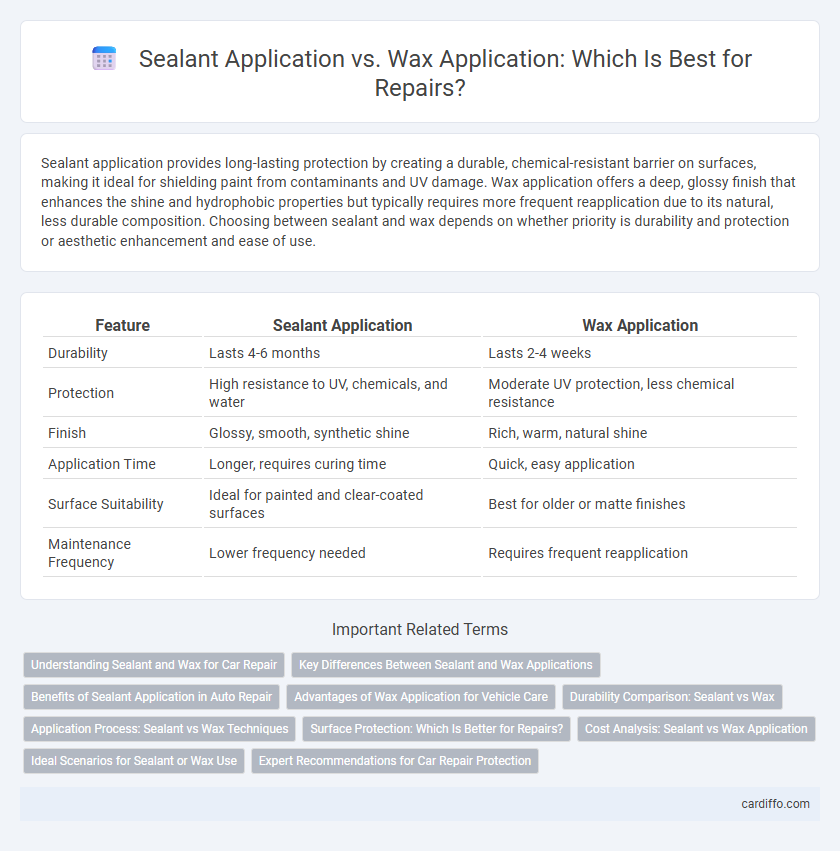Sealant application provides long-lasting protection by creating a durable, chemical-resistant barrier on surfaces, making it ideal for shielding paint from contaminants and UV damage. Wax application offers a deep, glossy finish that enhances the shine and hydrophobic properties but typically requires more frequent reapplication due to its natural, less durable composition. Choosing between sealant and wax depends on whether priority is durability and protection or aesthetic enhancement and ease of use.
Table of Comparison
| Feature | Sealant Application | Wax Application |
|---|---|---|
| Durability | Lasts 4-6 months | Lasts 2-4 weeks |
| Protection | High resistance to UV, chemicals, and water | Moderate UV protection, less chemical resistance |
| Finish | Glossy, smooth, synthetic shine | Rich, warm, natural shine |
| Application Time | Longer, requires curing time | Quick, easy application |
| Surface Suitability | Ideal for painted and clear-coated surfaces | Best for older or matte finishes |
| Maintenance Frequency | Lower frequency needed | Requires frequent reapplication |
Understanding Sealant and Wax for Car Repair
Sealant application in car repair provides a durable, long-lasting protective layer by chemically bonding to the paint surface, offering enhanced resistance to environmental contaminants and UV damage. Wax application, made from natural or synthetic ingredients, primarily adds a glossy finish and smooth texture but typically requires more frequent reapplication due to its less resilient nature. Understanding the differences in chemical composition and durability between sealants and waxes is crucial for optimizing paint protection strategies and maintaining vehicle aesthetics.
Key Differences Between Sealant and Wax Applications
Sealant application creates a durable, synthetic protective layer that bonds chemically to a vehicle's paint, providing long-lasting resistance against UV rays, contaminants, and water. Wax application, derived from natural or synthetic oils, offers a glossy finish and hydrophobic properties but typically requires more frequent reapplication due to its shorter durability. The primary difference lies in sealants' ability to maintain protection for up to six months with a harder finish, while waxes enhance appearance with a richer shine but need monthly upkeep.
Benefits of Sealant Application in Auto Repair
Sealant application in auto repair provides a durable, long-lasting protective layer that shields vehicle paint from UV rays, contaminants, and harsh weather conditions. It enhances surface hardness and water repellency, significantly reducing the risk of oxidation and corrosion compared to wax applications. Sealants require less frequent reapplication than wax, offering better cost-effectiveness and sustained aesthetic preservation over time.
Advantages of Wax Application for Vehicle Care
Wax application creates a durable protective layer on vehicle paint, enhancing gloss and repelling water, dirt, and contaminants more effectively than sealants. It nourishes the paint surface with natural oils and polymers, preventing oxidation and fading while providing a richer, deeper shine. Wax also offers easier maintenance and touch-ups, making it ideal for long-term vehicle care and aesthetic preservation.
Durability Comparison: Sealant vs Wax
Sealant application offers superior durability compared to wax, typically lasting 4 to 6 months versus wax's 4 to 6 weeks. Sealants form a stronger chemical bond with the vehicle's surface, providing enhanced resistance to environmental contaminants such as UV rays, acid rain, and road salts. Wax, while effective for short-term protection and a high-gloss finish, requires more frequent reapplication to maintain its protective qualities.
Application Process: Sealant vs Wax Techniques
Sealant application involves a precise, layered technique that requires the surface to be thoroughly cleaned and dried before applying a thin, even coat, which bonds chemically to the paint for long-lasting protection. Wax application typically uses a soft cloth or applicator pad to spread a thin, even layer in circular motions, allowing it to cure before buffing to a high gloss finish. Sealants generally require less frequent reapplication due to their durability, while waxes offer a rich luster but need more regular maintenance for optimal results.
Surface Protection: Which Is Better for Repairs?
Sealant application offers superior surface protection during repairs by forming a durable, long-lasting barrier against environmental contaminants and moisture. Unlike wax, which tends to wear off quickly and requires frequent reapplication, sealants chemically bond to the surface, enhancing resistance to UV damage and oxidation. For repair projects, sealants provide more reliable protection by preserving the integrity of the surface and extending the lifespan of the repair.
Cost Analysis: Sealant vs Wax Application
Sealant application typically costs more initially than wax application due to its advanced polymer formulas that provide longer-lasting protection, often up to six months or more. Wax application requires more frequent reapplication, generally every four to six weeks, which can increase long-term costs despite a lower upfront price. Considering durability and frequency, sealants offer better cost efficiency over time by reducing the need for repeated treatments.
Ideal Scenarios for Sealant or Wax Use
Sealant application is ideal for protecting vehicle paint in harsh weather conditions and for long-term durability, offering strong resistance against UV rays and chemical contaminants. Wax application is better suited for enhancing gloss and hydrophobic properties, making it perfect for short-term protection and aesthetic improvement. Choosing between sealant and wax depends on whether long-lasting defense or a shiny finish is the priority.
Expert Recommendations for Car Repair Protection
Experts recommend sealant application over wax for long-lasting car repair protection because sealants create a durable, synthetic barrier resistant to environmental damage and fading. Sealants can protect repaired surfaces from UV rays, water, and contaminants more effectively than traditional waxes. For optimal preservation of repair work, using high-quality paint sealants ensures enhanced protection and extended durability.
Sealant Application vs Wax Application Infographic

 cardiffo.com
cardiffo.com